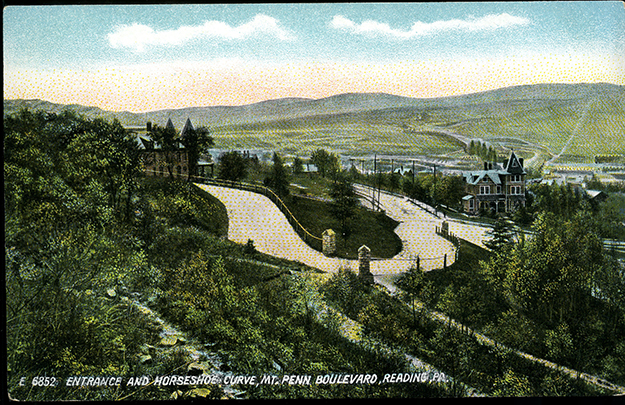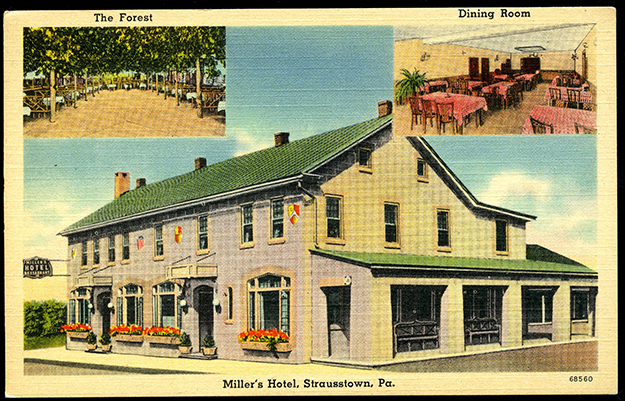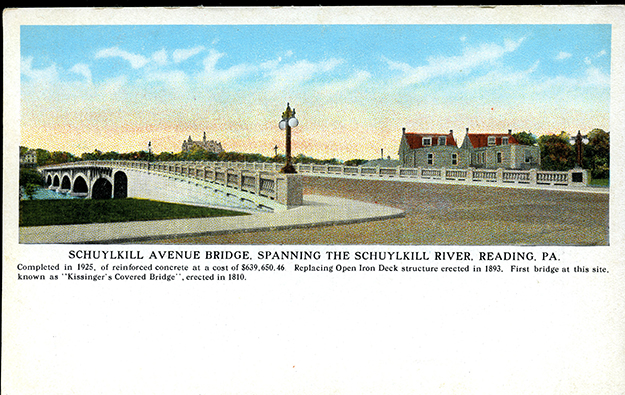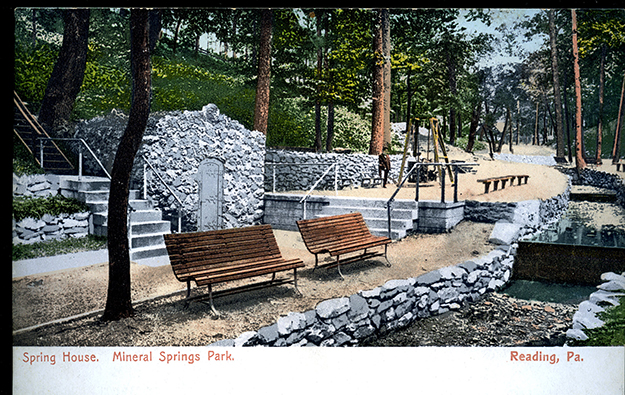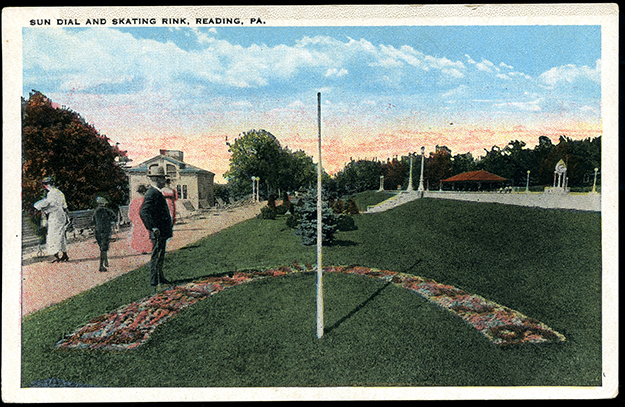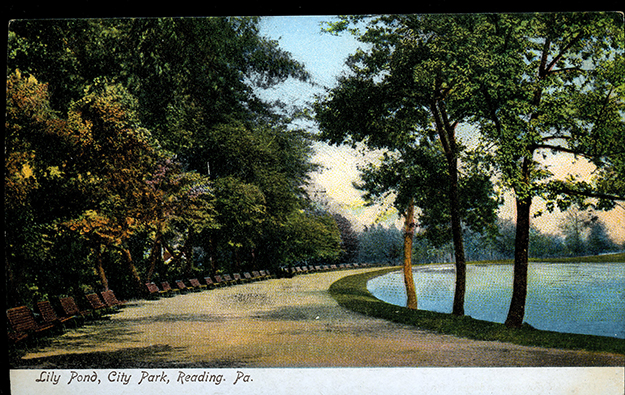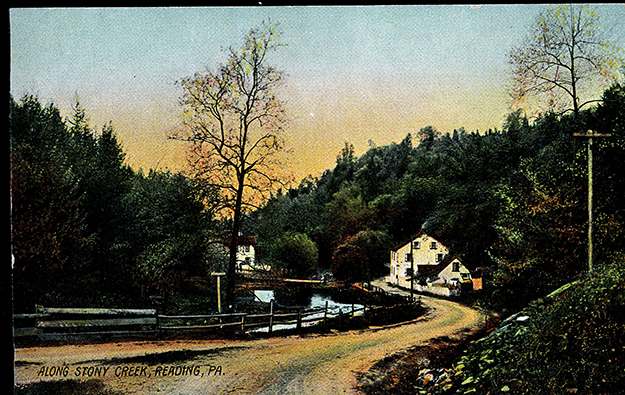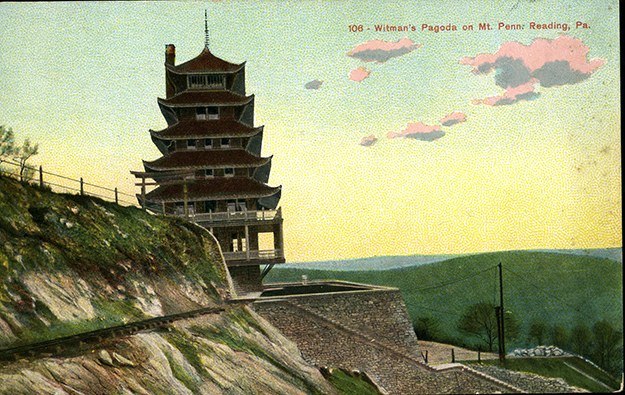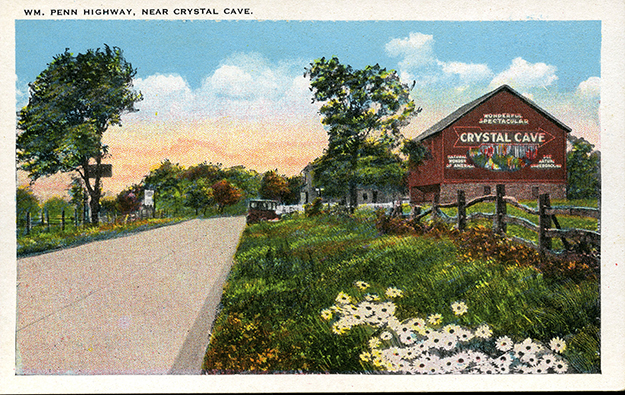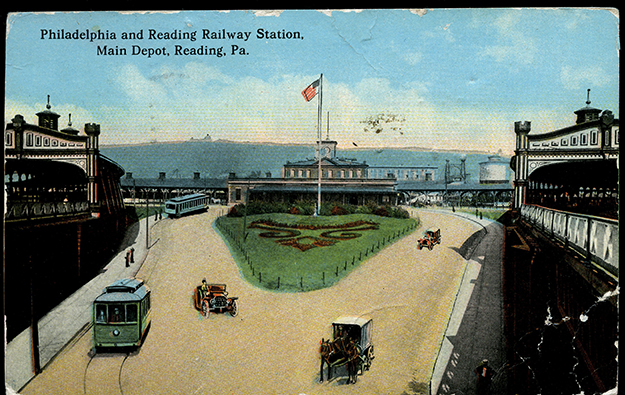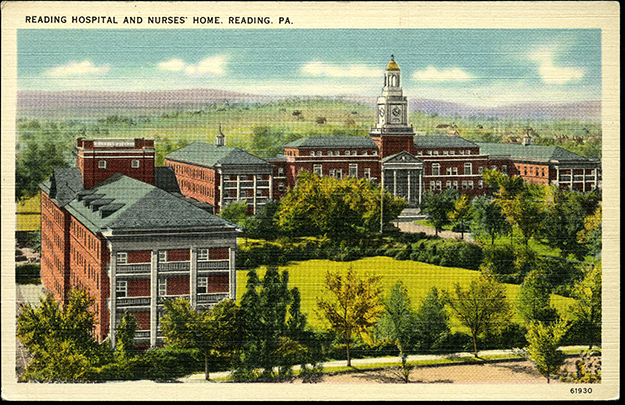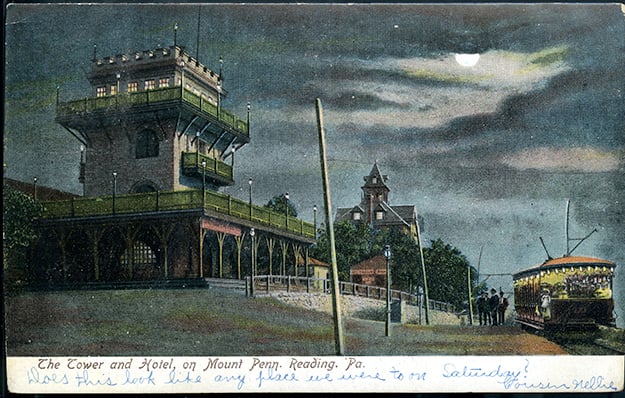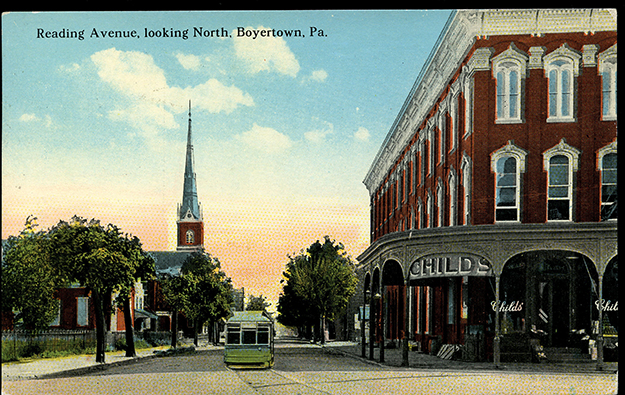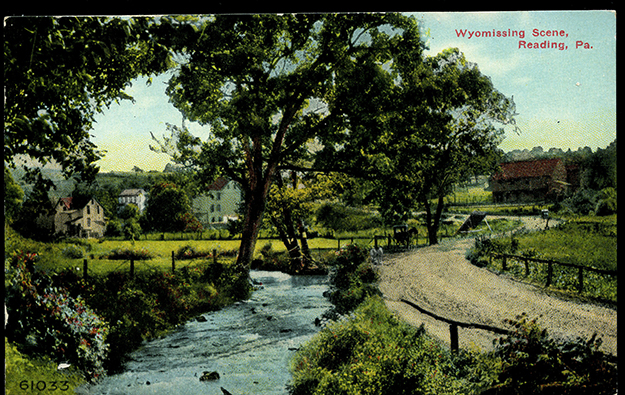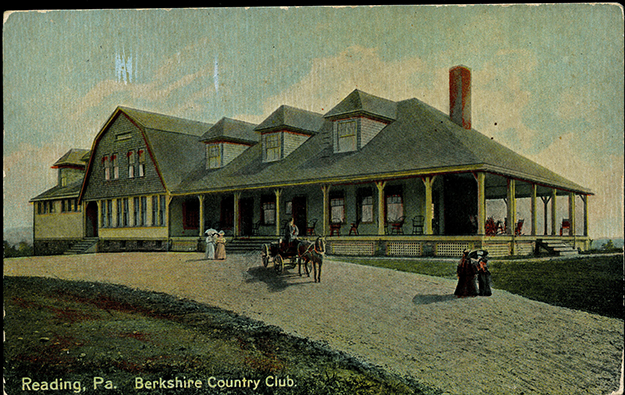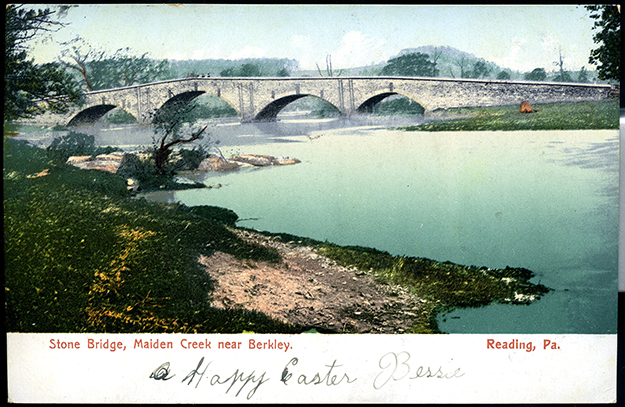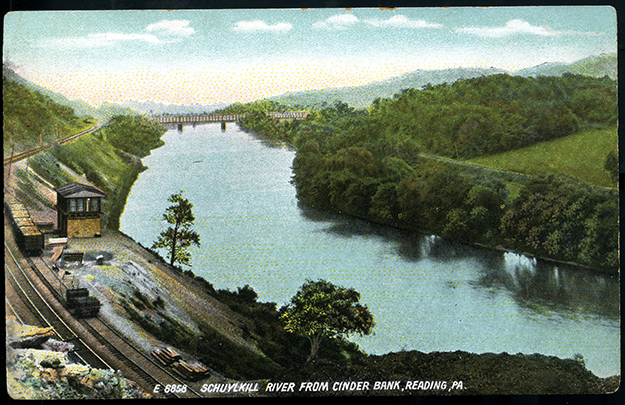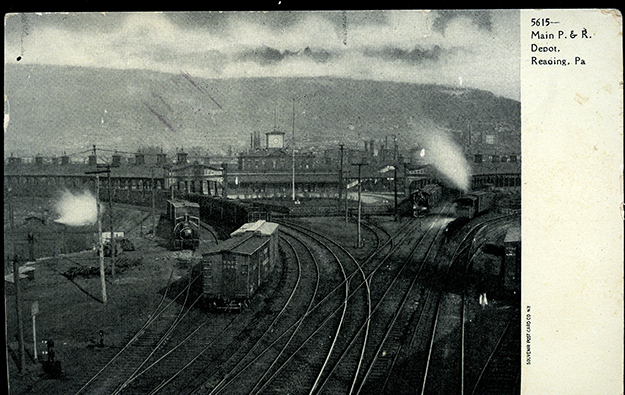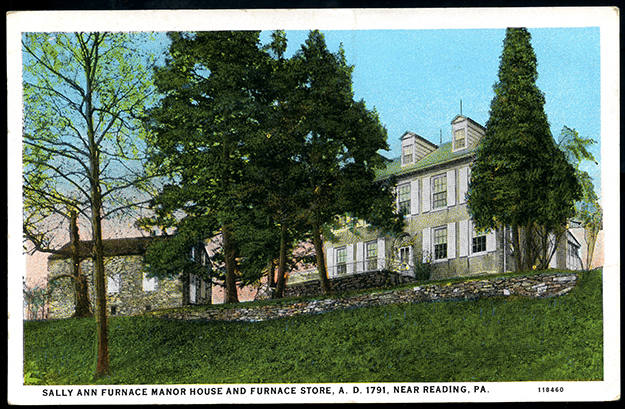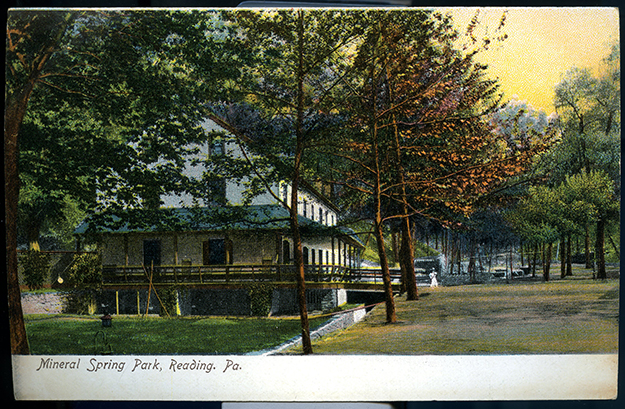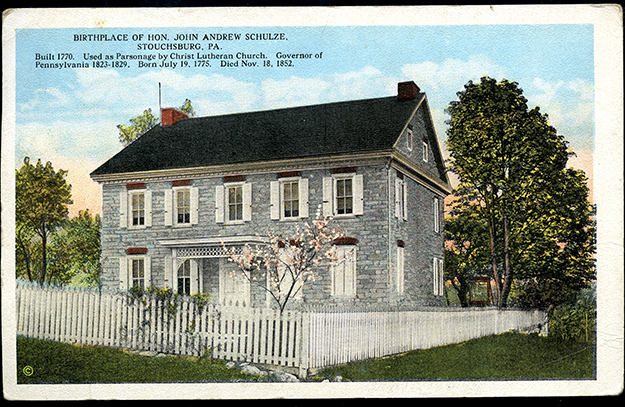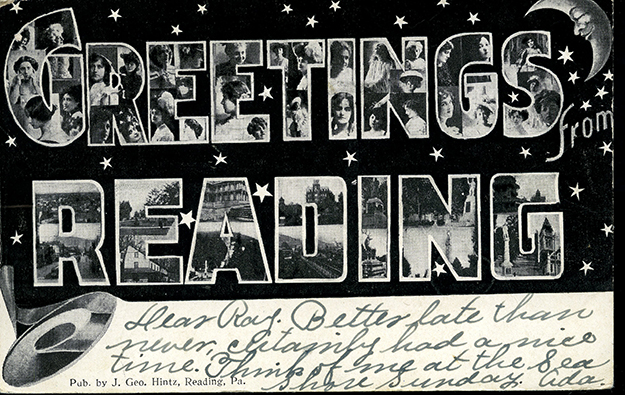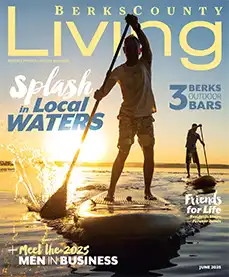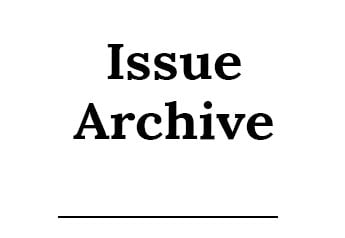
"Wish you were here!"
Thanks to Niépce, Daguerre, and all those other geniuses who changed our lives forever with the development of photography, those four words — though clichéd — say much about emotion and eyes. When we travel someplace new, want to share with friends and loved ones a vision of what we’re looking at, or want to remember exactly how something appears (aware of memory’s limitations), we rely on the camera to help us out. Words alone lack the power to fully and accurately explain how, exactly, the world looks. Paintings and drawings are great, but even they depend on artistic interpretation; they stray from being flat-out representation.
From the time when postcards came into vogue starting around the 1890s, they were a hit. Many were printed in Germany, a leader in lithographic processes. By the 1900s, you could hop a train from Philadelphia to Reading and mail back to your family a colorful picture of that bright red, gracefully Japanese-looking architectural oddity called Witman’s Pagoda, which overlooked the City of Reading, an urban hub which — with the exception of this Asian-style building — otherwise looked a whole lot like Germany, Belgium and Britain with its factories, matching brick rowhouses and multi-storied, sprawling Victorian mansions.
More than 100 years later, postcards from the past call up nostalgic recollections for older generations of Berks Countians who remember life and the way things looked before malls, big-box stores and arching highways.
One little postcard can stimulate a long, large conversation around a family table; it can launch a truly unique dialogue between a 7-year-old and a septuagenarian. It can even foster dynamic municipal change — toward re-greening by planting trees and flowerbeds; building handicap-accessible pathways and shelters; or creating rest stops for meditating, writing or conversing with friends on downtown streets. Sometimes, an old picture can spur communities to consider a return-to-the-past development plan for a skating rink, a lily pond, or rail service.
Comparing Views: Then and Now
Views of “how things used to be” spawn contemplation. For some folks, they jog the brain back to their own perceptions of the buildings and landscapes of their parents’ and grandparents’ lives. Comparing those to today’s actuality of the same geographical location can be a challenge, but with decent Google Earth skills, one could probably check out the current vista online. Or one could travel, DIY-Pokémon-Go-style, in the general direction of an old postcard’s image and see what has become of the site.
According to postcard expert and contemporary Berks postcards photographer Anthony Iezzi, “There are some people that really enjoy that. There’s actually a website where they hold up the old picture and the new one.” He says, “That concept is enjoyed by many. The contrast is appealing.”
In some cases, new excavations and infrastructures can make a comparison quite tough, if not impossible. But a surprising number of impressive buildings, pastoral settings, monuments, cityscapes, historical landmarks, and bridge structures still match up fairly well with earlier photo-cards.
Personal Sense of History
Reading City Councilwoman Donna Reed, former editor of the Historical Review of Berks County for the Berks History Center, is a fan of postcards from the past. “Like so many others,” she says, “I truly enjoy finding and acquiring old postcards of the Reading area. I love seeing what an area looked like decades or a century or more ago.”
Her private collection is typical for someone who mostly enjoys revisiting the sights that recall the past. “I have several favorites,” she says, “one a view of the Tuckerton area where I grew up, a circa 1904 'aerial' [actually rooftop view of Reading looking east before the construction of the Pagoda], many Pagoda scenes [from the 1920s to the 1960s], and a pre-1920s view of the old Rajah Theatre.”
Why postcards? Reed explains, “I think the attraction to old postcards of an area one knows well and perhaps has been raised in is this: While generations come and go, the places remain. We walk in the same steps in which our ancestors did. Old postcards give us a glimpse, an understanding, of what they saw. They create an important intergenerational commonality. I find that both fascinating and important to our understanding of place and time and where we fit in it. Old postcards and the scenes they reveal draw our eyes and our hearts into a time of history that has created the present as we know it.”
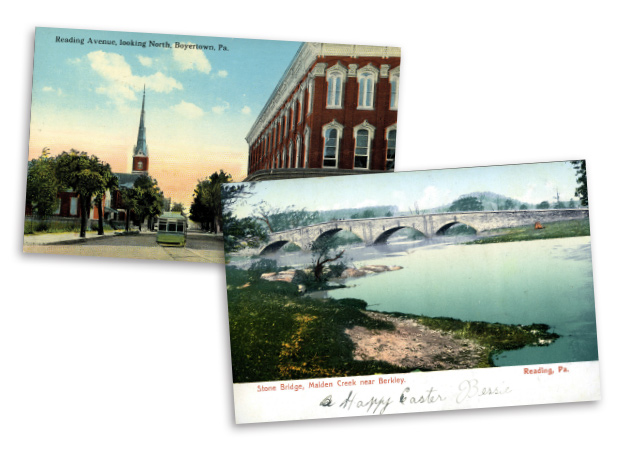
Diverse Landscapes, Views
The fact is, Berks County is a compelling and pretty place. Plus it’s got a highly graspable visual history, thanks to some help from something as simple and affordable as postcards. Due to its topographical diversity, there is nothing stopping a tourist, a newcomer, or a longtime Berks Countian from exploring a startlingly vast variety of settings within a single morning.
You can, for instance, slip a letter through a brass mail slot in Reading’s downtown, stone-solid, WPA-era United States Post Office at 9am; then walk your dog up around City Park, past the Volunteer Firemen’s Memorial Bandshell, monuments, and sculptures; then drive five minutes or so beyond the Lindbergh Viaduct to go check out the peace and quiet at Antietam Reservoir, where you’re now surrounded by deciduous trees and conifers. Head in the direction of Fleetwood, Oley, Topton, or Boyertown and let the eye go long, as they say, since sweeping cornfields and pasturelands unfold for miles upon miles. It’s not quite time for lunch, but you’ve already seen and felt a bustling urban environment with its imposing county courthouse, schools and trains; a mountainside with horseshoe turns; an area equally weighted with history and nature; sparkling bodies of water; and agricultural loveliness dotted with horses, cows, bank barns and picnic groves.
Visiting, Revisiting, Recording the Views
Iezzi also collects local postcards, but he’s happiest shooting new images of Berks County, creating collections of fresh postcards that he unveils every year.
“Photography has been my lifelong passion, and I am filled with excitement when I capture a unique scene and publish a postcard of that scene. I know the iconic scenes of Reading and Berks County now that I have been publishing postcards since 1982. So I have my eye on the weather forecast, waiting for those crystal blue skies after a rainstorm or the peaceful morning after a substantial snowfall. That’s when I will be in place at a historical site or a country scene just at the precise time that the sun’s rays blanket the site.”
Of all the images out there, Iezzi says, “postcards from the early 1900s and present-day postcards depicting the Reading Pagoda have been, by far, the most sought-after cards.”
When Visual Connections Become Collections
Donald Brown of Myerstown (just over the Berks County line) has amassed one of the largest postcard collections in the country — 500,000 by some estimates, with a substantial number from Pennsylvania. Now that’s serious business.
Closer to home, the widely respected author and radio personality Charles J. Adams III has written the dynamic, well-researched Reading in Vintage Postcards, part of Arcadia’s Postcard History Series.
Iezzi believes “Berks County folks are endeared with postcard collecting.” In fact, he says, “I am one who has fallen prey to the alluring attraction of that printed or real photo postcard. There is something that draws me and others to look into the past through a momentary image. My imagination is absorbed into the vintage postcard.”
Antique stores and open-air markets yield boxes of old postcards: these may be sorted or unsorted. At Renninger’s Antique and Farmer’s Market, Kutztown, the larger dealers display cards sorted neatly by different cities and regions of Pennsylvania or the world beyond. Cards can also be organized by style and theme: humor, romance, architecture, scenery, sports, and so forth. Postcards prior to 1907 might have writing on the front, since the reverse side was reserved for the address and stamp. While some prefer (and will pay more for) a pristine postcard front, others get a kick out of individual sentiments penned to the missive’s recipient — like this line “Cousin Nellie” wrote below an image of a steep entrance to City Park and Reservoir: “If you come to Reading again, we will walk up those steps.”
Where to Go
For postcarding info, postcard history, and weekend fun, check out:
Books
Reading in Vintage Postcards, Postcard History Series, by Charles J. Adams III at: amazon.com and arcadiapublishing.com
Old Postcard Hunting
Estate sales, auctions, yard sales. Check local newspapers, local signs, and The Merchandiser. See also themerchandiser.com (and click on “Reading Area,” then “Public Auction Calendar”).
Antique shops everywhere, including adjacent counties like Lebanon. See: readingberkspa.com, which brings viewers to visitpaamericana.com.
Renninger’s Antique and Farmer’s Market at 740 Noble St., Kutztown. See renningers.net.
Renninger’s Antique & Collectors Market at 2500 N. Reading Rd., Denver.
Stoudt’s Black Angus Antique Mall at 2800 N. Reading Rd., Adamstown. See stoudts.com (and click on “Antiques”).
Tony Iezzi’s Berks County Postcards
Iezzi’s latest images are carried in such places as the DoubleTree by Hilton Hotel Reading gift shop, West Reading Pharmacy, the Pagoda, and Ship-4-U in Wyomissing. “I am always interested in connecting with other postcard collectors and their collections. I am also able to evaluate collections,” says Iezzi. 610.914.2149. iezziphotography.com
About Deltiologist (Postcard Collector) Donald R. Brown
See: phmc.state.pa.us/bah/dam/mg/mg445.htm
Exhibitions
Postcards are often displayed in special shows and in museums, historical societies and galleries.
